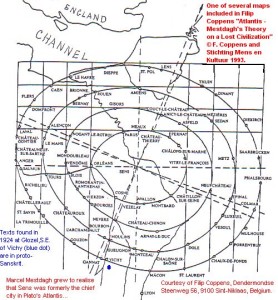Bruce Jeffries-Fox
Nabta Playa
Nabta Playa is a megalithic site situated 100 km west of Abu Simbel. It is the only known megalithic circle in Egypt, although in this instance ‘megalithic’ may be a misnomer as the components could have been erected by one person. A number of astronomical alignments have been identified at the site(a).
Although first rediscovered in 1974 by anthropology professor Fred Wendorf, it became known to a wider audience when astrophysicist Thomas G. Brophy published his book, The Origin Map[1510] in 2002. Wendorf was a contributor to a 2005 paper entitled Astronomy of Nabta Playa delivered to the African Astronomical History Symposium in Cape Town(g).>Wendorf also co-authored a paper with Romuald Schild in 2000 in which they offered a further detailed description of the site(i).<
The importance of Nabta Playa was further highlighted in a 2010 book by Robert Bauval & Thomas G. Brophy, Black Genesis[1508]. In it, they argue that the dark-skinned creators of Nabta Playa were the ancestors of the Egyptian culture, who migrated eastward as the Sahara dried up. The book has been reviewed favourably by Bruce Jeffries-Fox(b) and very critically by Jason Colavito in four parts(c-f). This was followed in 2012 by another book from Bauval & Brophy, Imhotep the African [1509], in which they explore further the development of ancient Egypt, particularly the part played by Imhotep.
Most sites(h) today (Sept. 2021) cite an estimated age of 7,000 years for Nabta Playa.
(a) https://humanoriginproject.com/nabta-playa-stone-circle/
(b) Origin of Egyptian Civilization (archive.org)
(c) https://www.jasoncolavito.com/blog/reviewing-black-genesis-pt-1
(d) https://www.jasoncolavito.com/blog/reviewing-black-genesis-pt-2
(e) https://www.jasoncolavito.com/blog/reviewing-black-genesis-pt-3
(f) https://www.jasoncolavito.com/blog/reviewing-black-genesis-final-part
(g) (PDF) Astronomy of Nabta Playa (archive.org) *
(h) Nabta Playa… – Physics and Nano
(i) Untitled (archive.org) *
Jeffries-Fox, Bruce
Bruce Jeffries-Fox is an American musician, who recently completed a musical based on the content of Sumerian cunieform tablets. influenced by the writings of Zechariah Sitchin!
His Enduring Mysteries website contains a number of interesting essays on ancient history subjects, which includes two(a)(b) devoted to the possibility of Atlantis in France, based on the ideas of Marcel Mestdagh and Philip Coppens’ book, The Lost Civilization Enigma [1275].
Mestdagh, Marcel
Marcel Mestdagh, (1926-1990) was a Belgian historian whose curiosity was  sparked by the discovery of unusual street patterns in the Belgian city of Ghent. This led to a lifelong interest in the Viking culture that had settled on both sides of the English Channel. It was this study of the Vikings that led him to realise that they had knowledge, now forgotten, of the purpose of many of the megalithic monuments which Mestdagh identified as a form of a road system, laid out in giant ovals with radials. At the centre of these ovals was the ancient city of Sens where the greatest concentration of megalithic monuments in France existed.
sparked by the discovery of unusual street patterns in the Belgian city of Ghent. This led to a lifelong interest in the Viking culture that had settled on both sides of the English Channel. It was this study of the Vikings that led him to realise that they had knowledge, now forgotten, of the purpose of many of the megalithic monuments which Mestdagh identified as a form of a road system, laid out in giant ovals with radials. At the centre of these ovals was the ancient city of Sens where the greatest concentration of megalithic monuments in France existed.
The late Philip Coppens informed us[1275.184] that a further strange discovery by Mestdagh was that the ancient road network he identified, centred on Sens, was mirrored by a similar network of roads in England centred on Nottingham!>>Mestdagh’s findings brings to mind another strange discovery in France claimed by Xavier Guichard (1870-1947) who was a police detective and philologist. Between 1911 and 1936 he carried out an extensive study of French place-names and found that there were at least 400 sites with names derived from Alesia and centred on today’s town of Alaise. When mapped, these hundreds of sites all lay on lines radiating from Alaise, reminiscent of Alfred Watkins leylines!<<
In the course of his investigations, Mestdagh discovered an aspect of the  Stonehenge-Avebury complex that had been overlooked, namely that the two sites were situated on the circumference of a huge oval. He further discovered that this oval was on a scale of 1/10th of the ovals that he had discovered in France. It will be obvious that ovals can be drawn using any two points.
Stonehenge-Avebury complex that had been overlooked, namely that the two sites were situated on the circumference of a huge oval. He further discovered that this oval was on a scale of 1/10th of the ovals that he had discovered in France. It will be obvious that ovals can be drawn using any two points.
{Filip} Philip Coppens, following Mestdagh’s work, has persuasively argued that Atlantis was the centre of a far-flung megalithic civilisation with its centre located where the ancient city of Sens now stands(e). Coppens returned to Mestdagh’s theories in his 2012 book, The Lost Civilisation Enigma[1275], which in turn led to two supportive essays from Bruce Jeffries-Fox in 2015(c)(d), who includes the observation that while Coppens was initially happy to follow Mestdagh and identify Sens as Atlantis he executed a volte-face and declared that “from c. 4500 to 1200BC, a major civilization existed in Europe about which we know very little.”
In a 1997 lecture(f) Coppens said “I believe that the megalithic civilization was instrumental in creating and propagating certain knowledge about things we are only now beginning to realise…….I wholeheartedly believe the megalithic civilization unravel certain enigmas that the Great Pyramid and all the wonders of Egypt and Sumer combined will not be able to solve.” Unfortunately, Coppens did not elaborate on the enigmas that he was referring to.
A Dutch website(a) give a brief overview of Mestdagh’s theory. Mestdagh’s Atlantis ideas were published posthumously by Coppens in two books, Atlantis [1289] and Pre-Atlantis[1290], both in Dutch.
A YouTube clip(b) also gives some idea of Mestdagh’s theory.
(a) https://www.kunstgeografie.nl/mestdagh1.htm (Dutch) (offline Dec. 2015)
(b) https://www.youtube.com/watch?v=hUHe8iOojqc
(c) Atlantis in France 1 (archive.org)
(d) Atlantis in France 2 (archive.org)
France *
France has had little mention in connection with the Atlantis mystery except by Marcel Mestadgh who was convinced that  France was the centre of an ancient civilisation with its capital in the city of Sens. The late Philip Coppens discussed Mestdagh’s theories in two of his books[0240][1275], which in turn led to a two-part essay(f)(g) by Bruce Jeffries-Fox.
France was the centre of an ancient civilisation with its capital in the city of Sens. The late Philip Coppens discussed Mestdagh’s theories in two of his books[0240][1275], which in turn led to a two-part essay(f)(g) by Bruce Jeffries-Fox.
However, in the early years of the 20th century Jean-Léopold Courcelle-Seneuil, a French writer, is reported to have proposed that the Auvergne region of Central France had been associated with Atlantis.
Another mysterious feature of ancient France is centred on the town of Alaise from which it was discovered that 24 radial ley lines emanated. These were identified by Xavier Guichard (1870-1947) a former Parisian police chief(e). In 1936, he self-published the heavily illustrated Eleusis Alesia [1699] outlining his research in great detail. John Sase, in his Curious Alignments [1589], confirmed Guichard’s findings.
However, in the 1990s Emile Mourey developed a theory that saw the Atlantean ‘Empire’ covering most of western Europe and all of North Africa as far east as Egypt. He places its capital at what is now the village of Gergovie(b) in the départment of Puy-de-Dôme. This Atlantis, according to Mourey, was not destroyed but after 509 BC was known as Gaul!
Brittany, in northwestern France, is the centre of some of the most spectacular megalithic monuments in Europe. From the middle of the 20th century onwards several researchers have striven to link Atlantis with these remarkable structures. In this connection the work of Deruelle, Tristan, Helmut Tributsch and Hank Harrison must be mentioned. French ethnologist Jean-Michel Hermans has recently joined the ranks of these supporters of a megalithic Atlantis.
In February 2019, a report in the Smithsonian Magazine told us that “Bettina Schulz Paulsson, an archaeologist at the University of Gothenburg, reexamined some 2,410 radiocarbon dating results that have been assigned to Europe’s megaliths and put them through Bayesian statistical analysis. Based on the picture the data present, Schulz Paulsson believes that the megaliths were first constructed by dwellers of northwest France during the second half of the fifth millennium BC.”(h) Mike Parker Pearson, the leading Stonehenge expert, has endorsed this idea of a French origin for megalith building(i) as has Aubrey Burl and more recently Robert Hensey [1766.6].
However, a note of caution has been expressed by Walter Willems in Der Spiegel, who has rightly pointed out that “there also exist megalithic structures in North Africa, as in Egypt, Libya, Tunisia and Morocco. These have hardly been dated up to now and were not taken into account in the analysis.”(j) I should add that similar monuments are to be found in the Caucasus, Jordan and Korea in great numbers and at many other locations around the globe, which should be included in a broader study.
Additionally, the ever-modest Dean Clarke has written(a) of a series of extensive prehistoric floods in France that he links with the flooding of Atlantis.
Timagenus, the Greek historian, noted that there were French tribes who claimed that Atlantis had been the home of their ancestors.
Returning to the matter of Atlantis, we find that Didier Coilhac has published an extensive paper in which he claims that statuary and paintings at the Palace of Versailles held encoded details of the story of Atlantis!(k) He has applied his theory to a number of other historical buildings and monuments(l).
(a) http://atlantisite.com/francetheory.htm (link broken) *
(b) https://www.agoravox.fr/tribune-libre/article/l-epopee-des-atlantes -capitale-125152
(d) http://www.ancient-wisdom.com/xavierguichard.htm
(e) https://web.archive.org/web/20171005192548/https://www.jiroolcott.com/blog/archives/7
(f) Atlantis in France 1 (archive.org)
(g) Atlantis in France 2 (archive.org)
(k) The Palace of Versailles codes Atlantis. (didiercoilhac.com) (French) (link broken)
(l) Home – Didier Coilhac (French) (link broken)
